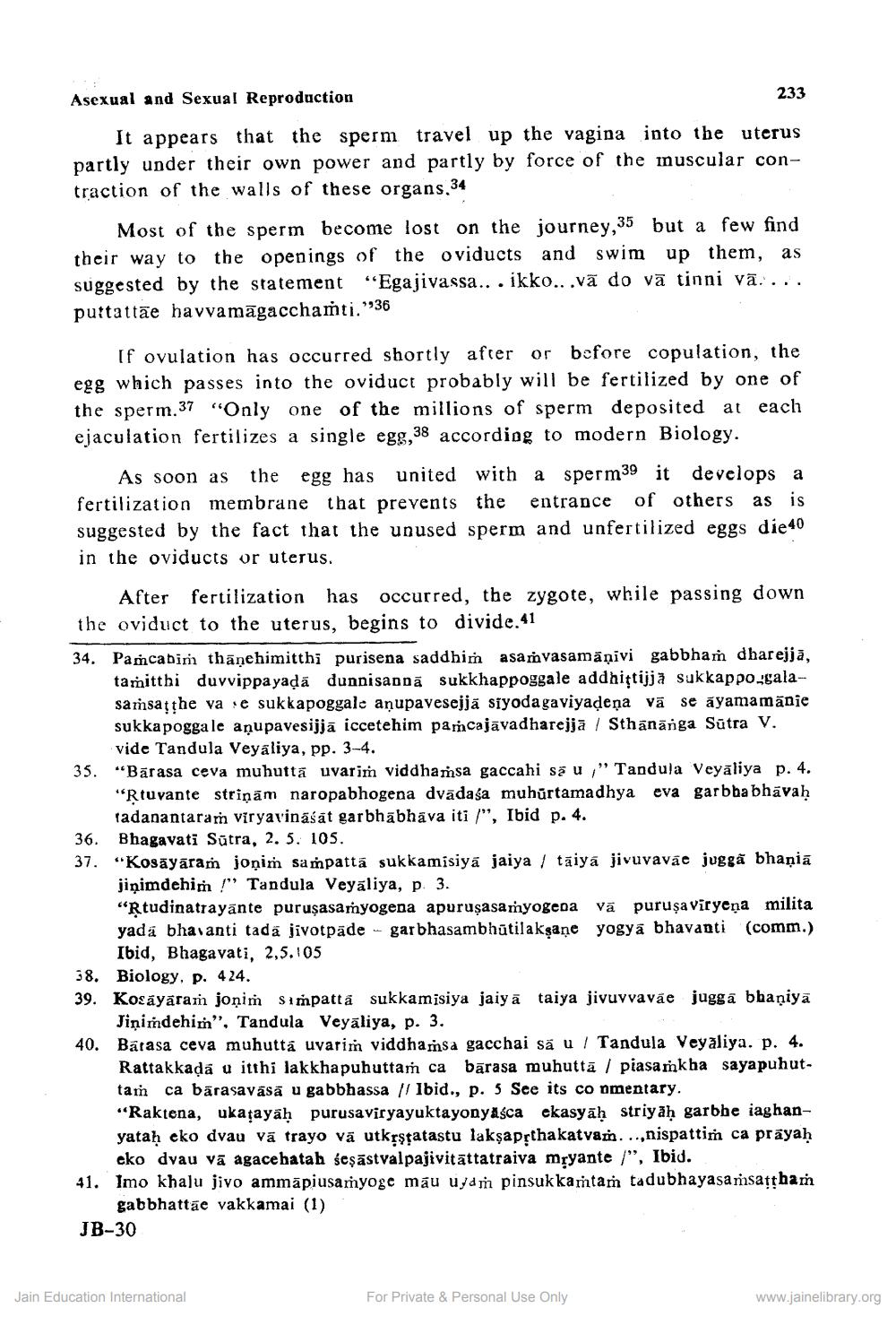________________
Asexual and Sexual Reproduction
233
It appears that the sperm travel up the vagina into the uterus partly under their own power and partly by force of the inuscular contraction of the walls of these organs.34
Most of the sperm become lost on the journey,35 but a few find their way to the openings of the oviducts and swim up them, as suggested by the statement "Egajivassa...ikko...vã do vā tinni vä.... puttattāe havvamāgacchamti.''36
If ovulation has occurred shortly after or before copulation, the egg which passes into the oviduct probably will be fertilized by one of the sperm.37 "Only one of the millions of sperm deposited at each ejaculation fertilizes a single egg, 38 accordiog to modern Biology.
As soon as the egg has united with a sperm 39 it develops a fertilization membrane that prevents the entrance of others as is suggested by the fact that the unused sperm and unfertilized eggs die40 in the oviducts or uterus.
After fertilization has occurred, the zygote, while passing down the oviduct to the uterus, begins to divide.41 34. Pancabim thāņehimitthi purisena saddhim asamvasamāṇivi gabbham dharejjā,
tamitthi duvvippayadā dunnisapdā sukkhappoggale addhittijja sukkappo.galasamsatthe va e sukkapoggale anupavesejjā siyodagaviyadeņa vā se āyamamänie sukka pogga le anupavesijjā iccetehim pamcajāvadharejjā / Sthanānga Sūtra V.
vide Tandula Veyaliya, pp. 3-4. 35. "Bārasa ceva muhutta uvarim viddhaṁsa gaccahi să u," Tandula Veyaliya p. 4.
"Rtuvante striņām naropabhogena dvadasa muhurtamadhya eva garbhabhāvah
radanantarar Viryavināśāt garbhābhāva iti /", Ibid p. 4. 36. Bhagavati Sūtra, 2. 5. 105. 37. “Kosāyāram jonim saṁpattā sukkamisiyā jaiya / taiya jivuvaväe juggă bhaņiā
jiņimdehim !" Tandula Veyaliya, p. 3. "Rtudinatrayante puruşasamyogena apuruşasamyogeda vā puruşa Viryeņa milita yada bha anti tada jivotpade - garbhasambhūtila kgane yogya bhavanti (comm.)
Ibid, Bhagavati, 2,5.105 38. Biology. p. 424. 39. Kosayāram jonim Simpatta sukkamisiya jaiya taiya jivuvvaväe jugga bhaniya
Jiņimdehim”. Tandula Veyāliya, p. 3. 40. Barasa ceva muhutta uvarim viddhamsa gacchai sa u / Tandula Veyaliya. p. 4.
Rattakkada u itthi lakkhapuhuttam ca bārasa muhutta / piasa mkha sayapuhuttam ca bārasavāsā u gabbhassa 11 Ibid., p. 5 See its conmentary. "Raktena, ukafayah purusa viryayukta yonyasca ekasyāh striyāḥ garbhe iaghanyataḥ eko dvau Vā trayo vā utkşşşatastu lakşapşthakatvan. .., nispattiṁ ca prāyaḥ
eko dvau vā agace hatah seșāstvalpajivitāttatraiva mțyante /", Ibid. 41. Imo khalu jivo ammāpiusamyoge mâu uyar pinsuk kamtam tadubhayasarsattham
gabbhattāe vakkamai (1) JB-30
Jain Education International
For Private & Personal Use Only
www.jainelibrary.org




